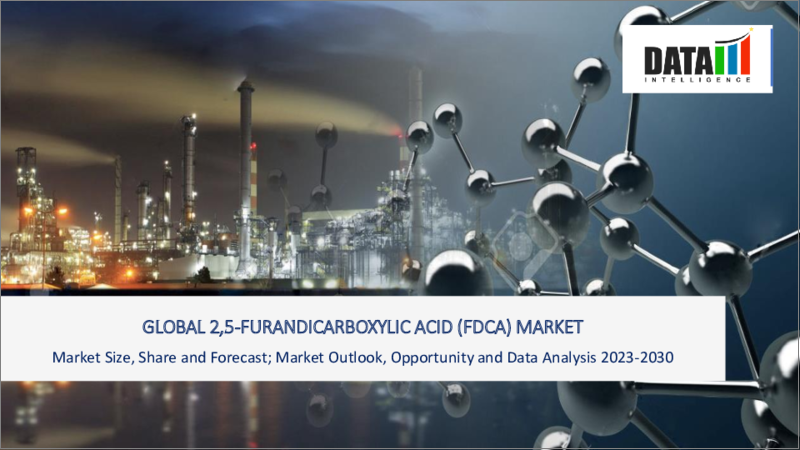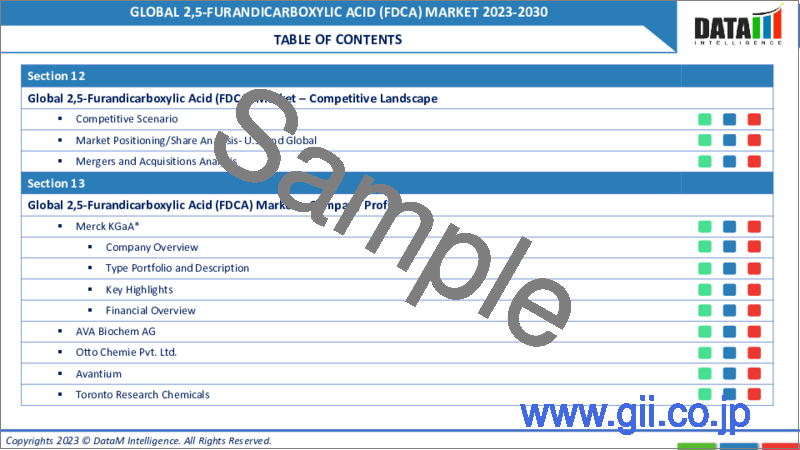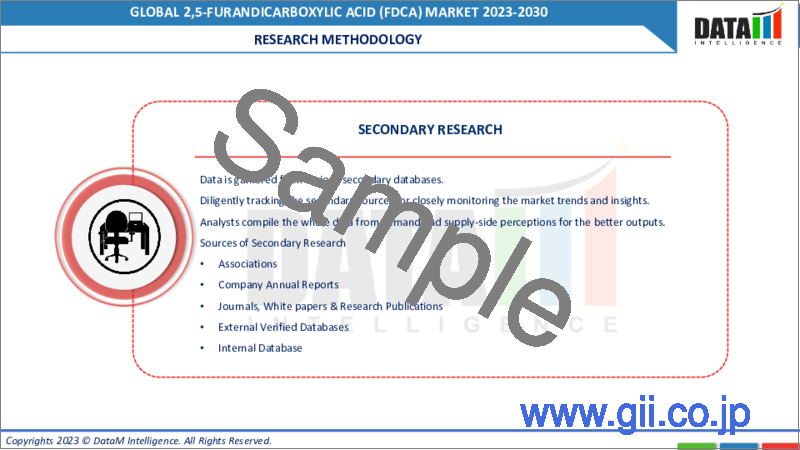|
|
市場調査レポート
商品コード
1336722
2,5-フランジカルボン酸の世界市場-2023年~2030年Global 2,5-Furandicarboxylic Acid Market - 2023-2030 |
||||||
カスタマイズ可能
適宜更新あり
|
|||||||
| 2,5-フランジカルボン酸の世界市場-2023年~2030年 |
|
出版日: 2023年08月22日
発行: DataM Intelligence
ページ情報: 英文 195 Pages
納期: 即日から翌営業日
|
- 全表示
- 概要
- 目次
市場概要
世界の2,5-フランジカルボン酸(FDCA)市場は、2022年に2億5,390万米ドルに達し、2023-2030年の予測期間中にCAGR 25.0%で成長し、2030年には15億1,300万米ドルに達すると予測されています。
予測期間中、プラスチック製品の使用に関する政府の規制がますます厳しくなっていることが、世界の2,5-フランジカルボン酸(FDCA)市場の成長を促進する可能性が高いです。厳しい罰則によって従来のプラスチックの使用が不経済になるため、製造業者はますますバイオプラスチックに切り替えるようになっています。バイオプラスチック生産の増加は、FDCAの需要を増大させると思われます。
将来の需要増加を見込んで、材料メーカーは新しいバイオベースの材料を開発するために、互いに協力的なパートナーシップを結ぼうとしています。例えば、フィンランドの素材会社Stora Ensoは2023年3月、韓国の化学会社Kolon Industriesとパートナーシップ契約を結び、Stora Enso独自のFDCA製造プロセスから新しいポリエステルを開発しました。
市場力学
持続可能な製品に対する需要の高まり
気候変動やプラスチック廃棄物に対する環境意識の高まりに伴い、より持続可能な製品に対する社会的需要が高まっています。FDCAは、バイオベースの原料から合成され、石油ベースの化学薬品に取って代わる可能性を秘めているため、二酸化炭素排出量を削減し、化石燃料への依存を減らすための魅力的な選択肢となります。
FDCAは、バイオベースポリマーであるポリエチレンフラノエート(PEF)の製造における主要成分です。PEFは優れたバリア特性を持ち、ボトルやフィルムなど様々な包装用途に使用できます。リサイクルと再利用を重視する循環型経済の採用も、FDCA需要の拡大に寄与しています。FDCA由来の製品は、従来の原料から開発された製品とは異なり、リサイクルが可能だからです。
新技術の進歩
新しい原料材料や製造方法を開発し、FDCAの潜在的用途を拡大するため、研究開発活動は近年加速しています。例えば、米国ウィスコンシン大学マディソン校の科学者チームは、フルクトースからFDCAを製造する経済的に実現可能な方法を実証しました。
高度な計算モデリング技術と実験を駆使して、研究者たちはFDCA生産プロセスを最適化し、無駄を省いて合成効率を高めることに成功しました。中国の広州にある中山大学(Sun Yat-Sen University)の科学者による2021年の調査では、5-ヒドロキシメチルフルフラールからFDCAを合成するための改善された方法を詳述した研究結果が2021年後半に発表されました。
限られた原料供給能力
FDCA生産の主な原料源は、植物廃棄物由来のバイオマス原料です。バイオマス原料の栽培には広大な耕地が必要であり、地域によっては問題があります。さらに、作物の収量は気候条件や土壌条件などさまざまな要因によって変動するため、原料の入手が不安定になる可能性があります。
バイオマス原料の栽培、収穫、輸送に必要なインフラは、ほとんどの発展途上地域では不十分か未発達です。これはサプライチェーンにおける大きな非効率につながり、原料の安定供給を妨げます。利用可能な原料が限られているため、FDCA生産の拡大が妨げられ、市場成長の課題となっています。
COVID-19影響分析
FDCA生産のための世界のサプライチェーンは、閉鎖や移動制限を含む様々な措置により混乱に見舞われました。パンデミック後の厳しい経済情勢により、いくつかの化学企業は大規模な投資を一時的に停止し、その結果FDCAの商業生産の拡大が制限されました。
パンデミックの後、世界の需要は大きく回復しましたが、サプライチェーンに残るさまざまな問題が、需要増に対応するための増産を妨げています。サプライチェーンの不安定さは短期的には続くと予想され、市場の成長にとって一時的な課題となると思われます。
ロシア・ウクライナ戦争の影響分析
現在進行中のロシアとウクライナの戦争は、世界市場に大きな影響を与えることはないと思われます。従って、戦争に関連した混乱が市場関係者に大きな課題をもたらしません。ほぼすべての主要な開発はアジア太平洋と北米で行われており、戦争による直接的な影響はありません。
目次
第1章 調査手法と調査範囲
第2章 定義と概要
第3章 エグゼクティブサマリー
第4章 市場力学
- 影響要因
- 促進要因
- 持続可能な製品に対する需要の増加
- 新しい技術の進歩
- 抑制要因
- 利用可能な原料の制限
- 機会
- 影響分析
- 促進要因
第5章 産業分析
- ポーターのファイブフォース分析
- サプライチェーン分析
- 価格分析
- 規制分析
第6章 COVID-19分析
第7章 タイプ別
- 99%
- 98%
- 97%
- その他
第8章 原料別
- 炭水化物
- 再生可能バイオマス
第9章 用途別
- ポリエステル
- ポリアミド
- ポリカーボネート
- 可塑剤
- ポリエステルポリオール
- ポリエチレンフラノエート(PEF)
- ボトル
- 繊維
- フィルム
- その他
第10章 エンドユーザー別
- 化学品
- 医薬品
- 科学研究
- その他
第11章 地域別
- 北米
- 米国
- カナダ
- メキシコ
- 欧州
- ドイツ
- 英国
- フランス
- イタリア
- スペイン
- その他欧州
- 南米
- ブラジル
- アルゼンチン
- その他南米
- アジア太平洋
- 中国
- インド
- 日本
- オーストラリア
- その他アジア太平洋
- 中東・アフリカ
第12章 競合情勢
- 競合シナリオ
- 市況/シェア分析
- M&A分析
第13章 企業プロファイル
- Merck KGaA
- 会社概要
- 製品ポートフォリオと説明
- 財務概要
- 最近の動向
- AVA Biochem AG
- Otto Chemie Pvt. Ltd.
- Avantium
- Toronto Research Chemicals
- V & V Pharma Industries
- Tokyo Chemical Industry Co., Ltd.
- Thermo Fisher Scientific
- AstaTech, Inc.
- Novamont S.p.A.
第14章 付録
Market Overview
Global 2,5-Furandicarboxylic Acid (FDCA) Market reached US$ 253.9 million in 2022 and is expected to reach US$ 1,513.0 million by 2030, growing with a CAGR of 25.0% during the forecast period 2023-2030.
During the forecast period, increasingly stringent government regulations on the usage of plastic articles is likely to propel the growth of the global 2,5-furandicarboxylic acid (FDCA) market. With strict penalties making usage of conventional plastic uneconomical, manufacturers are increasingly switching to bioplastics. The growth in bioplastic production will augment demand for FDCA.
With anticipation of increased future demand, material manufacturers are entering into collaborative partnerships with each other to develop new bio-based materials. For instance, in March 2023, Stora Enso, a Finnish materials company signed a partnership agreement with Kolon Industries, a South Korean chemicals company, do develop a new polyester from Stora Enso's proprietary FDCA production process.
Market Dynamics
Increasing Demand for Sustainable Products
With increasing environmental awareness about climate change and plastic waste, public demand has increased for more sustainable products. FDCA is synthesized from bio-based feedstocks and has the potential to replace petroleum-based chemicals, make it an attractive option to reduce carbon emissions and decrease reliance on fossil fuels.
FDCA is a key component in the production of bio-based polymer polyethylene furanoate (PEF). PEF has superior barrier properties and can be used in various packaging applications, including bottles and films. The adoption of circular economy, which emphasis recycling and reuse, is also conducive to the growth in demand for FDCA, since FDCA-derived products can be recycled unlike those developed from traditional feedstocks.
New Technological Advancements
Research and development activities have accelerated in recent years to develop new feedstock materials, production methods and expand the potential applications for FDCA. For instance, a team of scientists from the University of Wisconsin-Madison in U.S. demonstrated an economically feasible method for production of FDCA from fructose.
Using advanced computational modeling techniques and experiments, researchers have been able to optimize the FDCA production process, reducing wastage and increasing synthesis efficiency. A 2021 study by scientists from the Sun Yat-Sen University in Guangzhou, China, published a research study in late 2021, detailing an improved method for FDCA synthesis from 5-hydroxymethylfurfural.
Limited Feedstock Availability
The major sources of raw material for FDCA production are biomass feedstocks derived from plant waste. Biomass feedstocks require vast arable land for cultivation, which can be problem in certain regions. Furthermore, crop yields vary depending on various factors including climate conditions, soil conditions and which can lead to volatility in feedstock availability.
The infrastructure required for the cultivation, harvesting and transportation of biomass feedstocks ise inadequate or underdeveloped in most developing regions. It can lead to major inefficiencies in the supply chain, hindering the steady supply of feedstocks. The limited availability of feedstocks hampers FDCA production expansion and presents a challenge for market growth.
COVID-19 Impact Analysis
The global supply chain for FDCA production experienced disruptions due to varioous measures including lockdowns and movement restrictions. The difficult economic situation in the wake of the pandemic led several chemical companies to temporarily suspend major investments, thereby causing restrictions on expanding the commercial production of FDCA.
Although global demand has undergone major recovery in the aftermath of the pandemic, various lingering supply chain problems have prevented manufacturers from increasing production to cater to growing demand. The supply chain volatilities are expected to continue over the short-term and will present temporary challenges for market growth.
Russia-Ukraine War Impact Analysis
The ongoing war between Russia and Ukraine will not have major discernable impact on the global market. In the pre-war period, both countries generated negligible demand for FDCA, therefore, war-related disruptions will not present major challenges to the market players. Almost all major developments are taking place in Asia-Pacific and North America, which are not directly impacted by the war.
Segment Analysis
The global 2,5-furandicarboxylic acid (FDCA) market is segmented based on type, raw material, application, end-user and region.
The Chemical Industry is the Biggest End-User for FDCA
The chemical industry is by far, the largest end-user of FDCA, accounting for a market share of nearly 83% in 2022. FDCA demand from the chemical industry has gained tremendous popularity due to the growing significance of sustainability feedstocks in chemical production. Various developing regions are investing in boosting the demand for green chemicals by gradually shifting away from petroleum-based feedstock materials to bio-based feedstock materials.
The increasing demand for sustainable bio-derived polymers has also sparked growing interest in FDCA production. Terephthalic acid, a petroleum-derived monomer used to create polymers for food and beverage packaging, shares structural similarities with FDCA. One of the major commercial applications is the usage of FDCA as a sustainable substitute for terephthalic acid in polymer production.
Geographical Analysis
Government Support and Industry Collaborations to Propel Market Growth
North America accounted for 32% of the global market in 2022. The market in North America is growing due to shifting lifestyles and rising consumer demand for bio-based packaging. The 2,5-furandicarboxylic acid market is expected to expand due to technological advancements and increased demand for novel synthetic chemicals and materials. Furthermore, stringent government rules regarding plastic usage are also likely to augment market growth over the medium and long term.
U.S. Department of Energy (U.S. DoE) has designated FDCA as one of the 12 priority chemicals for developing the green chemistry sector. It was never commercialized in industrial proportions since the production technique was not profitable. The instability of the intermediate required for manufacturing FDCA, 5-hydroxymethylfurfural (HMF) is the main problem for economically viable HMF manufacturing.
Companies are creating collaborative inter-industry partnerships to increase research pace into development of new applications for FDCA. For instance, in March 2023, Origin Materials, a U.S.-based material science company entered into a partnership with Avantium, a Dutch material technology company to develop economical methods for FDCA production from wood residue.
Competitive Landscape
The major global players include: Merck KGaA, AVA Biochem AG, Otto Chemie Pvt. Ltd., Avantium, Toronto Research Chemicals, V & V Pharma Industries, Tokyo Chemical Industry Co., Ltd., Thermo Fisher Scientific, AstaTech, Inc. and Novamont S.p.A.
Why Purchase the Report?
- To visualize the global 2,5-furandicarboxylic acid (FDCA) market segmentation based on type, raw material, application, end-user and region, as well as understand key commercial assets and players.
- Identify commercial opportunities by analyzing trends and co-development.
- Excel data sheet with numerous data points of 2,5-furandicarboxylic acid (FDCA) market-level with all segments.
- PDF report consists of a comprehensive analysis after exhaustive qualitative interviews and an in-depth study.
- Product mapping available as Excel consisting of key products of all the major players.
The global 2,5-furandicarboxylic acid (FDCA) market report would provide approximately 64 tables, 72 figures and 195 Pages.
Target Audience 2023
- Polymer Manufacturers
- FDCA Manufacturers
- Industry Investors/Investment Bankers
- Research Professionals
- Emerging Companies
Table of Contents
1. Methodology and Scope
- 1.1. Research Methodology
- 1.2. Research Objective and Scope of the Report
2. Definition and Overview
3. Executive Summary
- 3.1. Snippet by Type
- 3.2. Snippet by Raw Material
- 3.3. Snippet by Application
- 3.4. Snippet by End-User
- 3.5. Snippet by Region
4. Dynamics
- 4.1. Impacting Factors
- 4.1.1. Drivers
- 4.1.1.1. Increasing demand for sustainable products
- 4.1.1.2. New technological advances
- 4.1.2. Restraints
- 4.1.2.1. Limited feedstock availability
- 4.1.3. Opportunity
- 4.1.4. Impact Analysis
- 4.1.1. Drivers
5. Industry Analysis
- 5.1. Porter's Five Force Analysis
- 5.2. Supply Chain Analysis
- 5.3. Pricing Analysis
- 5.4. Regulatory Analysis
6. COVID-19 Analysis
- 6.1. Analysis of COVID-19
- 6.1.1. Scenario Before COVID
- 6.1.2. Scenario During COVID
- 6.1.3. Scenario Post COVID
- 6.2. Pricing Dynamics Amid COVID-19
- 6.3. Demand-Supply Spectrum
- 6.4. Government Initiatives Related to the Market During Pandemic
- 6.5. Manufacturers Strategic Initiatives
- 6.6. Conclusion
7. By Type
- 7.1. Introduction
- 7.1.1. Market Size Analysis and Y-o-Y Growth Analysis (%), By Type
- 7.1.2. Market Attractiveness Index, By Type
- 7.2. 99%*
- 7.2.1. Introduction
- 7.2.2. Market Size Analysis and Y-o-Y Growth Analysis (%)
- 7.3. 98%
- 7.4. 97%
- 7.5. Others
8. By Raw Material
- 8.1. Introduction
- 8.1.1. Market Size Analysis and Y-o-Y Growth Analysis (%), By Raw Material
- 8.1.2. Market Attractiveness Index, By Raw Material
- 8.2. Carbohydrates*
- 8.2.1. Introduction
- 8.2.2. Market Size Analysis and Y-o-Y Growth Analysis (%)
- 8.3. Renewable Biomass
9. By Application
- 9.1. Introduction
- 9.1.1. Market Size Analysis and Y-o-Y Growth Analysis (%), By Application
- 9.1.2. Market Attractiveness Index, By Application
- 9.2. Polyester*
- 9.2.1. Introduction
- 9.2.2. Market Size Analysis and Y-o-Y Growth Analysis (%)
- 9.3. Polyamides
- 9.4. Polycarbonates
- 9.5. Plasticizers
- 9.6. Polyester Polyols
- 9.7. Polyethylene Furanoate (PEF)
- 9.7.1. Bottles
- 9.7.2. Fibers
- 9.7.3. Films
- 9.8. Others
10. By End-User
- 10.1. Introduction
- 10.1.1. Market Size Analysis and Y-o-Y Growth Analysis (%), By End-User
- 10.1.2. Market Attractiveness Index, By End-User
- 10.2. Chemicals*
- 10.2.1. Introduction
- 10.2.2. Market Size Analysis and Y-o-Y Growth Analysis (%)
- 10.3. Pharmaceuticals
- 10.4. Scientific Research
- 10.5. Others
11. By Region
- 11.1. Introduction
- 11.1.1. Market Size Analysis and Y-o-Y Growth Analysis (%), By Region
- 11.1.2. Market Attractiveness Index, By Region
- 11.2. North America
- 11.2.1. Introduction
- 11.2.2. Key Region-Specific Dynamics
- 11.2.3. Market Size Analysis and Y-o-Y Growth Analysis (%), By Type
- 11.2.4. Market Size Analysis and Y-o-Y Growth Analysis (%), By Raw Material
- 11.2.5. Market Size Analysis and Y-o-Y Growth Analysis (%), By Application
- 11.2.6. Market Size Analysis and Y-o-Y Growth Analysis (%), By End-User
- 11.2.7. Market Size Analysis and Y-o-Y Growth Analysis (%), By Country
- 11.2.7.1. U.S.
- 11.2.7.2. Canada
- 11.2.7.3. Mexico
- 11.3. Europe
- 11.3.1. Introduction
- 11.3.2. Key Region-Specific Dynamics
- 11.3.3. Market Size Analysis and Y-o-Y Growth Analysis (%), By Type
- 11.3.4. Market Size Analysis and Y-o-Y Growth Analysis (%), By Raw Material
- 11.3.5. Market Size Analysis and Y-o-Y Growth Analysis (%), By Application
- 11.3.6. Market Size Analysis and Y-o-Y Growth Analysis (%), By End-User
- 11.3.7. Market Size Analysis and Y-o-Y Growth Analysis (%), By Country
- 11.3.7.1. Germany
- 11.3.7.2. UK
- 11.3.7.3. France
- 11.3.7.4. Italy
- 11.3.7.5. Spain
- 11.3.7.6. Rest of Europe
- 11.4. South America
- 11.4.1. Introduction
- 11.4.2. Key Region-Specific Dynamics
- 11.4.3. Market Size Analysis and Y-o-Y Growth Analysis (%), By Type
- 11.4.4. Market Size Analysis and Y-o-Y Growth Analysis (%), By Raw Material
- 11.4.5. Market Size Analysis and Y-o-Y Growth Analysis (%), By Application
- 11.4.6. Market Size Analysis and Y-o-Y Growth Analysis (%), By End-User
- 11.4.7. Market Size Analysis and Y-o-Y Growth Analysis (%), By Country
- 11.4.7.1. Brazil
- 11.4.7.2. Argentina
- 11.4.7.3. Rest of South America
- 11.5. Asia-Pacific
- 11.5.1. Introduction
- 11.5.2. Key Region-Specific Dynamics
- 11.5.3. Market Size Analysis and Y-o-Y Growth Analysis (%), By Type
- 11.5.4. Market Size Analysis and Y-o-Y Growth Analysis (%), By Raw Material
- 11.5.5. Market Size Analysis and Y-o-Y Growth Analysis (%), By Application
- 11.5.6. Market Size Analysis and Y-o-Y Growth Analysis (%), By End-User
- 11.5.7. Market Size Analysis and Y-o-Y Growth Analysis (%), By Country
- 11.5.7.1. China
- 11.5.7.2. India
- 11.5.7.3. Japan
- 11.5.7.4. Australia
- 11.5.7.5. Rest of Asia-Pacific
- 11.6. Middle East and Africa
- 11.6.1. Introduction
- 11.6.2. Key Region-Specific Dynamics
- 11.6.3. Market Size Analysis and Y-o-Y Growth Analysis (%), By Type
- 11.6.4. Market Size Analysis and Y-o-Y Growth Analysis (%), By Raw Material
- 11.6.5. Market Size Analysis and Y-o-Y Growth Analysis (%), By Application
- 11.6.6. Market Size Analysis and Y-o-Y Growth Analysis (%), By End-User
12. Competitive Landscape
- 12.1. Competitive Scenario
- 12.2. Market Positioning/Share Analysis
- 12.3. Mergers and Acquisitions Analysis
13. Company Profiles
- 13.1. Merck KGaA*
- 13.1.1. Company Overview
- 13.1.2. Product Portfolio and Description
- 13.1.3. Financial Overview
- 13.1.4. Recent Developments
- 13.2. AVA Biochem AG
- 13.3. Otto Chemie Pvt. Ltd.
- 13.4. Avantium
- 13.5. Toronto Research Chemicals
- 13.6. V & V Pharma Industries
- 13.7. Tokyo Chemical Industry Co., Ltd.
- 13.8. Thermo Fisher Scientific
- 13.9. AstaTech, Inc.
- 13.10. Novamont S.p.A.
LIST NOT EXHAUSTIVE
14. Appendix
- 14.1. About Us and Services
- 14.2. Contact Us





